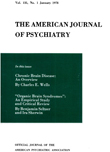TREATMENT OF SCHIZOPHRENIC REACTIONS WITH PHENOTHIAZINE DERIVATIVES
Abstract
Six hundred forty newly-admitted schizophrenic men in 35 VA hospitals were randomly assigned to chlorpromazine, triflupromazine, mepazine, prochlorperazine, perphenazine and phenobarbital groups. Treatment followed a double blind procedure for 12 weeks. Patients were started on low "equivalent" doses of each drug which were gradually increased in a predetermined manner during the first 4 weeks. During the final 8 weeks, each prescribing physician adjusted the dose for each of his patients in order to evoke an optimal therapeutic response.
Average daily doses during the flexible period were: chlorpromazine, 635 mg.; triflupromazine, 175 mg.; mepazine, 190 mg. ; prochlorperazine, 90 mg. ; and perphenazine, 50 mg. Clinical evaluations using two rating scales provided 24 criteria of change. For each criterion, the mean of each of the 6 treatment groups adjusted for the net effect of 12 control variables was compared by analysis of multiple covariance with the mean of every other treatment group at each of three evaluation periods; first month, the following 2 months, and over the entire 3 months. Side effects, hematologic and hepatic function data were also recorded during the course of treatment. One hundred sixty-eight patients failed to complete the study.
In general, the results indicated that all 5 phenothiazine derivatives were therapeutically more effective than phenobarbital. Mepazine was less effective than the other 4 drugs at the doses employed. No significant differences in therapeutic efficacy were noted between chlorpromazine, triflupromazine, prochlorperazine, and perphenazine. Criterion measures showing change toward improvement after treatment with phenothiazine derivatives included resistiveness, belligerence, thinking disturbance, and degree of illness. Other criteria affected favorably, especially by the 4 more potent phenothiazines, were motor disturbance, paranoid projection, perceptual distortion and withdrawal.
Only 21 patients (3%) were discontinued from treatment because of side reactions or deviant laboratory tests. Most side reactions, especially the extrapyramidal syndromes, were produced by perphenazine and prochlorperazine. Phenobarbital was associated with a number of side reactions ("turbulence," autonomic symptoms) commonly attributed only to the phenothiazine derivatives. Abnormal hematologic tests including eosinophilia, leucocytosis and leucopenia were neither frequent nor severe. The distribution of the 36 patients with leucopenia was not significantly different among the treatment groups. Continued treatment with the drugs in 31 leucopenic patients produced no case of agranulocytosis. Although abnormal hepatic tests occurred in 88 patients, these were sporadic. No clearcut case of jaundice or hepatic dysfunction was encountered during treatment.
Access content
To read the fulltext, please use one of the options below to sign in or purchase access.- Personal login
- Institutional Login
- Sign in via OpenAthens
- Register for access
-
Please login/register if you wish to pair your device and check access availability.
Not a subscriber?
PsychiatryOnline subscription options offer access to the DSM-5 library, books, journals, CME, and patient resources. This all-in-one virtual library provides psychiatrists and mental health professionals with key resources for diagnosis, treatment, research, and professional development.
Need more help? PsychiatryOnline Customer Service may be reached by emailing [email protected] or by calling 800-368-5777 (in the U.S.) or 703-907-7322 (outside the U.S.).



